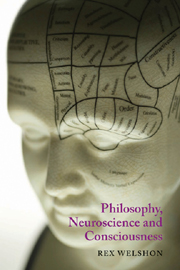Book contents
- Frontmatter
- Contents
- Preface
- Introduction
- PART I PHILOSOPHY AND CONSCIOUSNESS
- PART II NEUROSCIENCE AND CONSCIOUSNESS
- 5 Cortical evolution and modularity
- 6 Arousal, perception and affect
- 7 Attention, working memory, language and executive function
- 8 Neural models of conscious properties
- PART III PHILOSOPHY, NEUROSCIENCE AND CONSCIOUSNESS
- Concluding semi-scientific postscript
- Appendix Functional neuroanatomy
- Notes
- Bibliography
- Index
8 - Neural models of conscious properties
from PART II - NEUROSCIENCE AND CONSCIOUSNESS
- Frontmatter
- Contents
- Preface
- Introduction
- PART I PHILOSOPHY AND CONSCIOUSNESS
- PART II NEUROSCIENCE AND CONSCIOUSNESS
- 5 Cortical evolution and modularity
- 6 Arousal, perception and affect
- 7 Attention, working memory, language and executive function
- 8 Neural models of conscious properties
- PART III PHILOSOPHY, NEUROSCIENCE AND CONSCIOUSNESS
- Concluding semi-scientific postscript
- Appendix Functional neuroanatomy
- Notes
- Bibliography
- Index
Summary
The research reviewed in previous chapters establishes neuroanatomical correlates for particular perceptual, affective and cognitive processes that happen also to be conscious. This approach, by far the most prevalent in neuroscience, identifies neuroanatomical correlates for specific processes, hoping thereby to capture consciousness in the process by capturing it in the processes. Another approach that works from general properties of consciousness to neural correlates for those properties has also gained considerable traction in the neuroscience community. This approach, which provides neural models of consciousness and conscious properties, is this chapter's topic.
A noticeably high incidence of disagreement permeates this research. Granted, many of the views share certain commitments. Chief among them are the following: (i) neuroanatomical correlates of conscious properties provide evidence that particular kinds of neural activity are the substrates of conscious properties; (ii) at least some conscious properties are necessary for some kinds of information processing; (iii) intentionality is representational and computational; and (iv) qualitative properties are distinct from content properties. But there is dissent, especially from (iii) and (iv). Those who claim that intentionality is computational often look askance at qualitative properties and argue that they must be computational or at least representational, while those who claim that conscious properties are biological sometimes argue that qualitative properties cannot be computational or representational. Others also split content and qualitative properties off from higher-order, monitoring, self-and reflective-conscious properties, arguing that none is reducible to the others and that one or another or all are or are not scientifically tractable.
- Type
- Chapter
- Information
- Philosophy, Neuroscience and Consciousness , pp. 172 - 195Publisher: Acumen PublishingPrint publication year: 2010



